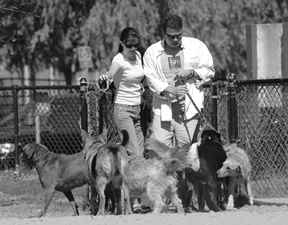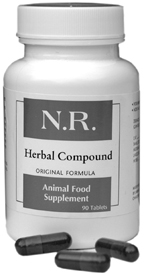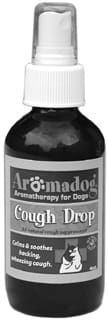The headlines would frighten anyone. “Mysterious Dog Flu Found in Boarded Pets,” said the front page of New York’s Westchester/Rockland County Journal News on September 24, 2005. “Virulent Dog Virus Hits Area Kennels,” warned the New York Times a day later.
In less than two weeks, the Times ran five news stories about the illness. “Dogs Stay In as Rumors Run Free,” its October 7 feature, summed things up. Frightened New Yorkers were keeping their dogs home while buzz about the new disease spread faster than the virus that caused it. Radio stations, TV networks, newspapers, Web sites, and online chat rooms picked up the story.

And it’s a scary tale. In late August and early September, 100 dogs at Best Friends Pet Care Center in Chestnut Ridge, New York, and another 40 dogs at Graceland Kennels across the Hudson River in North Castle, New York, developed what veterinarians at first assumed was kennel cough. Instead, they had a new form of influenza. Several developed pneumonia and had to be hospitalized. One of them died.
By all accounts, the virus developed in Florida. On August 12, shortly before the New York outbreak, Cynda Crawford, DVM, PhD, an immunologist at the University of Florida’s College of Veterinary Medicine in Gainesville, issued an advisory warning that “outbreaks of canine influenza virus, which causes an acute respiratory infection, have been identified in dogs in shelters, humane societies, boarding facilities, and veterinary clinics in Florida.”
By October 15, cases had been reported in Alabama, Arizona, Arkansas, California, Colorado, Florida, Iowa, Kansas, Massachusetts, New Jersey, New York, North Carolina, Ohio, Oregon, Texas, Washington state, West Virginia, and Wisconsin. By the time you read this, the list will be longer.
Viral activity
That’s because canine flu has a very high infection rate. “Dogs have no natural immunity to the virus, so virtually every animal exposed will be infected. About 80 percent of dogs that are infected with the virus will develop symptoms,” says Dr. Crawford.
Although most common where dogs are in close proximity – in kennels, shelters, dog parks, grooming salons, training schools, and dog shows – canine flu can be contracted through the air or through exposure to contaminated surfaces. Anyone and anything that has been in contact with infected dogs can be a vector. Some Florida kennel workers carried the virus home with them and spread it to other dogs.
“Think of this as the canine equivalent of colds and flu that people get,” says Carol Falck, VMD, in Pompano Beach, Florida. “It spreads in just the same way, through direct contact, through the air, and through exposure to whatever the virus touches.”
The symptoms are similar, too, with infected dogs developing a runny nose, fever, and a persistent cough that can last for two to three weeks. But the severity of symptoms varies. “That’s because there are two forms of the illness,” explains Dr. Falck. “The mild form can come and go unnoticed, but the dog will still be a carrier. In fact, you can’t tell anything about a dog’s canine flu status by its appearance, because a dog can look and act perfectly normal and still have an active infection. The more severe form of canine flu has obvious, acute symptoms that can turn into pneumonia.”
According to Debbye Turner, DVM, a consulting veterinarian to CBS TV’s Early Show, the canine flu’s signature cough is different from kennel cough. “Kennel cough is a hacking cough, and the dog usually feels fine otherwise,” she explains. “With canine flu, you’ll see a soft, moist cough. You’re also going to see a high fever in the dog; nasal discharge; rapid, shallow breathing; loss of energy; and loss of appetite.” These last symptoms manifest when the illness progresses to pneumonia. Canine flu does not tend to produce vomiting, diarrhea, or other intestinal problems.
The canine flu virus is not related to human flu or to the avian (bird) flu that has killed people in Asia. No humans have been infected with the canine flu.
New and fatal?
With veterinarians claiming a 100 percent infection rate, canine flu sounds like the human flu pandemic scientists have been warning us about, something that could kill just about any and every dog.
In truth, the canine flu’s mortality rate is very low, with most estimates at around 5 percent. Those at greatest risk of developing complications are older dogs, young puppies, and any dog with a weak immune system.
And yes, it’s new – but not that new. According to Edward Dubovi, PhD, director of Cornell University’s Animal Health Diagnostic Center’s virology laboratory, the illness was first identified two years ago.
In January 2004, 22 Greyhounds in a Florida racing kennel came down with an unusual respiratory disease and eight of them died. Dr. Crawford sent tissue samples from the infected dogs to Dr. Dubovi, who isolated the influenza virus. Researchers at the Centers for Disease Control and Prevention in Atlanta, Georgia, then typed and sequenced the virus. It was found to belong to the H3N8 virus strain, which causes influenza in horses.
In 2004, 14 Greyhound racetracks in six U.S. states reported outbreaks of respiratory disease, as did 20 tracks in 11 states during the first nine months of 2005. Although researchers did not investigate every outbreak, they found evidence of H3N8 wherever they looked.
Is your dog at risk?
The short answer to this question is yes. Even if canine flu hasn’t infected your neighborhood, it eventually will. When researchers tested dogs in shelters and at veterinary clinics in Florida and New York, they found that up to 97 percent already had antibodies to the H3N8 virus.
“This suggests,” says Dr. Falck, “that it’s far more widespread, at least in affected areas, than most people realize. If you live near an outbreak area, the odds are very high that your dog has already been exposed or soon will be. Wherever you live, this flu will eventually arrive.”
The virus is airborne and spreads easily. Most dogs who develop symptoms do so within 24 to 72 hours of exposure, although the exact incubation period is unknown. An infected dog will be contagious for at least a few days and possibly weeks. No one knows how long the virus is viable on surfaces, but it probably survives for 24 hours and may live much longer.
The risk of infection is obviously highest where dogs are in close proximity, especially if they are under stress. This is why dogs in shelters, grooming salons, training schools, shows and competitions, and boarding kennels are so vulnerable.
At People Training for Dogs in Nyack, New York, eight miles from the Chestnut Ridge outbreak, trainer Nancy Strouss has been educating clients about canine flu. “I suggest that they not board their dogs in a stressful kennel and consider hiring a housesitter or finding someone who boards dogs in their home,” she says. “I also suggest that if they must go to the vet, that they leave their dog in the car until the vet is ready and then take the dog directly into the exam room instead of sitting in the waiting room with unknown dogs.”
She also screens dogs to help prevent exposure. “I tell clients that if their dogs have even a mild cough, runny nose, or other respiratory symptoms, they should not come to class but contact their veterinarian and me immediately. Dogs who were recently purchased or adopted from shelters must wait at least two weeks before starting class, to be sure they don’t have symptoms.”
An ounce of prevention
Florida veterinarian Mary Foster, DVM, has not yet had to treat canine flu, but she is busy with prevention.
“Everything comes down to the dog’s immune system,” she says. “There is no vaccine for the canine flu, but even if a vaccine were available today, I would advise my clients not to use it. Even conventional veterinary textbooks now recognize that vaccines can suppress certain immune functions, and researchers find that skin conditions, cancers, and other chronic problems are most common in dogs who are frequently vaccinated.
“The other key factor is diet. You can do a lot to improve your dog’s immune system just by improving the quality of his food,” she says. Like many holistic veterinarians, Dr. Foster recommends feeding a raw, home-prepared diet that does not include grains.
When it comes to supplements, Dr. Foster avoids synthetic vitamins in favor of whole-food supplements such as those from Standard Process.
“The products I use most for preventing viral infections are Thymex, which is a thymus gland supplement that stimulates an immune response, and Cataplex A-C-P, which is an antioxidant-bioflavonoid blend that increases white blood cells and improves lung-related respiratory diseases.” Dr. Foster adjusts the dose according to the dog’s size.
She also looks for zinc deficiencies because zinc helps protect the body from viruses. “The Standard Process product Trace Minerals B12 contains a little of everything,” she says, “and it helps dogs maintain proper zinc levels without causing any long-term harm.
Dr. Foster says calcium is important, too. “When calcium levels are low, you become more susceptible to infections, whether bacterial or viral. Calcium lactate is more quickly absorbed than calcium carbonate or other calcium supplements. When a dog is stressed, such as when you’re going to a dog show or taking a trip, make sure she has plenty of available calcium. I use Standard Process calcium lactate tablets, anywhere from three to six per day depending on the size of the dog. If the dog does get sick, I’d give two every hour. Calcium works best when given on an empty stomach, an hour before feeding or two hours after.”
Dr. Foster’s other favorite supplement is Pet’s Friend Immu GO, which contains dessicated spleen, thymus, and bone marrow and which she considers a powerful immune system booster.

An herbal classic
Juliette de Bairacli Levy, the famous herbalist whose Natural Rearing philosophy has improved the health of dogs for more than 60 years, is best known for advocating a raw, home-prepared diet. She suggests protecting dogs against viruses with an herbal compound that contains garlic, rue, sage, thyme, eucalyptus, and wormwood – all serious infection fighters – in a base of vegetable charcoal.
According to her Complete Herbal Handbook for the Dog and Cat, these stimulate immunity, maintain health, promote healing in infected animals, and prevent infection if used before and after exposure to other dogs.
Coconut oil
Dr. Foster recommends feeding coconut oil to dogs as a flu preventive, and coconut oil expert and book author Bruce Fife, ND, agrees. “Taking coconut oil every day, preferably two or three times per day, is an excellent way to prevent infection,” says Dr. Fife. “The medium-chain fatty acids in coconut oil kill most strains of flu virus and, taken daily, should be effective against the canine flu.”
“What interests me most about coconut oil,” says Dr. Foster, “is that it actually attacks viruses that are lipid-coated. I suspect that because the H3N8 virus is lipid-coated, it is especially susceptible to the medium-chain fatty acids in coconut oil.”
The recommended dose is 1 teaspoon per 10 pounds of body weight daily, or 1 tablespoon per 30 pounds. It works best in divided doses, and it’s a good idea to start with smaller amounts to let the dog’s body adjust without causing diarrhea. Coconut oil can be added to any meal; most dogs so enjoy the taste that they’ll eat it off the spoon. (For more information, see “Crazy About Coconut Oil,” WDJ October 2005.)
Gastrointestinal support
According to San Diego veterinarian Stephen R. Blake, the most important defense against any infection, whether fungal, viral, or bacterial, is the gastro-intestinal system. “Since 70 percent of antibody-producing gamma globulin comes from Pyres patches in the intestinal tract,” he says, “and 90 percent of all toxins, bacteria, viruses, and fungi enter the body through the gut, it only makes sense that we should concentrate our effort on this organ system.”
Dr. Blake considers vaccines inappropriate for acute viral infections that have a high rate of infection and low mortality rate. “Our efforts should be on supporting the immune system through a healthy GI tract, not injecting more toxins into the system, which will stress it even further.”
Dr. Blake’s favorite supplement for immune support is bovine colostrum from New Zealand from pasture-fed, organically raised cattle. Colostrum is the “first milk” a cow produces after giving birth, and it contains all the immune support a baby calf needs to avoid infection. Cows produce colostrum in far greater quantities than their calves can consume, so the excess is collected and powdered for supplement use.
“I recommend a dose of 500 mg colostrum per 25 pounds of body weight once or twice a day, depending on the dog’s risk factor,” says Dr. Blake.
Other supplements that support the gastrointestinal tract include probiotics, such as Lactobacillus acidophilus and other “friendly” or “beneficial” bacteria, which help make up the body’s first line of defense against viruses and other pathogens. (Interestingly, this year scientists at Seoul National University in Korea isolated nine strains of Lactobacillus bacteria in kimchi, that country’s famous spicy sauerkraut. One strain proved so successful at preventing and treating avian flu that it is being tested as a commercial feed supplement.)
Acidophilus supplements are especially important for dogs who have been treated with antibiotics, as antibiotics destroy these beneficial microbes. Several probiotic supplements have been developed for dogs and are sold in pet supply stores or veterinary clinics.
Aromatherapy to the rescue
The use of essential oils and hydrosols derived from the leaves, roots, bark, and blossoms of aromatic plants is becoming increasingly popular among holistic veterinarians (as described in “Smell This, You’ll Feel Better,” December 2004, and “Essential Information,” January 2005).
For example, Dr. Foster applies 1 drop or less of lavender essential oil to the paw pads of dogs who are under stress to help them relax and to help prevent infection. Like many essential oils, lavender has antiviral properties.
Dr. Blake combines essential oils to protect dogs at risk of infection. “I mix 10 drops of frankincense, 2 drops of lemon essential oil, and 1 ounce (2 tablespoons) of water,” he says. “Massage this blend into the paw pads and around the head and neck, keeping it away from the dog’s eyes. You can repeat this process throughout the day, depending on the risk and how the dog responds. Frankincense and lemon are both bactericidal and viricidal. Keep a vegetable oil handy in case any essential oil accidentally gets in the eyes. Essential oils are not water-soluble, so you can’t rinse them off with water.”
Dr. Falck relies on blends from Aromadog, which makes a variety of therapeutic and grooming products. Her favorite for canine flu prevention and treatment is Cough Drop!, which her clinic has been testing for several weeks.
“We’ve used it for a variety of respiratory conditions, possibly including canine flu, and the results have been phenomenal,” she reports. “We spray it around dogs so they can breathe the mist. Cough Drop! is handy because you can take it with you and use it whenever needed. You can take it to the groomer, or if your pet’s being boarded, you can ask the kennel to use it as a preventive. It helps prevent and treat kennel cough, too.”
To create Cough Drop!, Aromadog founder Faith Thanas blended ravensara, Eucalyptus radiata, spike lavender, and African sage essential oils, all of which have significant antiviral properties.
“It’s important to shake this blend vigorously to remix and reactivate it,” she says, “then thoroughly mist the air around your dog from a distance of two to three feet, including over the dog’s head. Repeat every two to three hours, and spray doorknobs, walls, and infected surfaces, too. One of the greatest advantages of this blend is its quick response time. Breathing passages open up, and this is so soothing for the chest. It brings immediate relief.”
Don’t panic
As the canine flu virus spreads across North America and the world, it will continue to generate confusion and distress. “Headlines and rumors always paint a worst-case scenario,” says Dr. Falck, “but they don’t have to apply to your dog. With a little help, your dog’s immune system can respond efficiently to any contagious disease, including canine flu.”
-A long-time contributor to WDJ and author of The Encyclopedia of Natural Pet Care, Natural Remedies for Dogs & Cats, and other books, CJ Puotinen lives in New York with her husband, a Lab, and a tabby cat.






